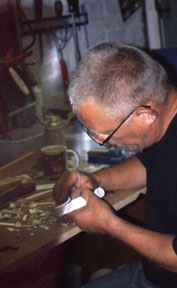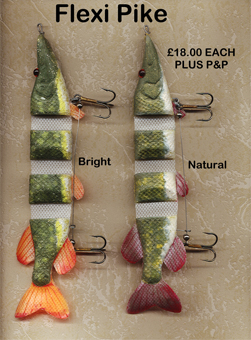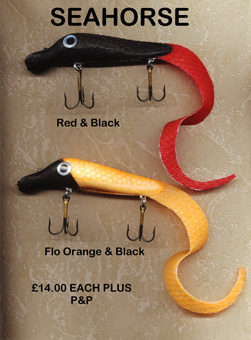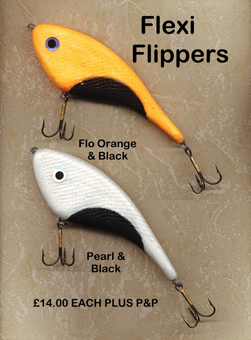History

Carving a pattern for the Sea Horse.
Flexi Lures came into existence through a suggestion that was put to me at a local PAC meeting back in February 1999, being a carpenter, I was asked if I could make some jerk bait blanks for the other members to weight and decorate. During the evening the subject of what wood was the most suitable for making jerk baits and although no one knew exactly why, maple was thought to be the best. When I came away from the meeting my head was spinning with ideas and the more I thought about it, the more I was convinced that wood was not the material to use, as the density is never the same from one piece to another. I also reasoned that as with wooden blanks lead is added to get the right sink rate, then surely a material that sank could have buoyancy added to it to get the same effect. If this material could be moulded then there would be no variations in the density, so a search was on for a material that was easy for me to work with, that would do everything that I wanted. After trying all sorts of weird and wonderful things I settled on silicon rubber.
The first prototypes were made from moulding silicon, with buoyant plugs that could be added or removed to change the sink rate. These were a complete and utter failure. Undeterred, I persevered with silicon, despite the many problems that it presented especially the decorating of the lure.
After three and a half years and hundreds of failed prototypes, I had a small range of rubber lures that if nothing else were different. Made from various silicon compounds with a reinforcing membrane through the centre.
They were extremely strong compared with soft plastic baits, they could withstand very high temperatures, would not leach colours when mixed, and were safe to put into any type of plastic box. Any cuts or rips caused by pike’s teeth could easily be repaired with general-purpose silicon sealant.
Although cast in a mould all the lures were individually made, and hand painted with finger and brush to get the effects. Therefore, no two lures will be exact copies.
The following gives a brief description of some the lures back then.
Flexi Pike

There were two lures in this range natural and bright. Both swimming in an upright position, having a medium sink rate, cranked at a steady pace it had a snake like action. A good action could be had by fishing it in a series of twitches and jerks, making it shoot off to the side slightly.
Seahorse

A lure with a medium sink rate it combines the fluttering tail action of most soft baits with the inbuilt action of a crankbait. Trolled or retrieved at a steady pace it would wander from side to side with a slight roll, fluttering its tail behind. A very good action could be obtained by letting it sink to the desired depth and then jerking it back, but with upward jerks of the rod, the effect was for it to shoot from one side to the other whilst maintaining its depth for most of the retrieve.
Flexi Flipper

There were two versions of this jerk bait slow and medium sink. Fished on a standard jerk retrieve they would glide from side to side and hang /sink tail down, the slow sink flipper could be fished on and just under the surface, shooting side to side and flipping over on the surface if jerked, with a combination of upward and sideways jerks of the rod as soon as the lure hits the water.